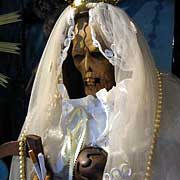Catholic Church doesn't condone Mexico's
'St. Death' phenomenon
By Chris Hawley | The Arizona
Republic

MEXICO CITY — Deep in the heart of
Mexico City's toughest neighborhood, in streets plagued by drugs
and prostitution, faithful Catholics are praying to a new and
fearsome saint: death itself.
They come by the
dozens to the Mercy Church, a former house in the Tepito
neighborhood stuffed with statues and posters of the Grim Reaper,
known among the devotees as St. Death.
They ask La Santa
Muerte for miracles, light candles and give offerings of food,
liquor and cigarettes. Some bring their children, who look up with
awe at the grinning skeletons and their scythes.
The Roman
Catholic Church says the veneration of St. Death is growing in
Mexico despite attempts by priests to stop it. There are 40
shrines to Death in Mexico City and about 400 nationwide, said
David Romo Guillen, bishop of the Traditional Catholic Church Mex-USA,
which runs the Mercy Church and has become the most visible
promoter of St. Death.
There are five
prayer groups in California, Oregon and Washington, D.C., Romo
said.
"It has become a
fad, and it's growing very quickly," said Sergio Roman, a Roman
Catholic official who oversees the priesthood in Mexico City.
"People have taken death and personified it. They've made it
almost like a god."
Devotees say
death worship stretches back to pre-Columbian times in Mexico, and
the veneration of saints is popular among Catholics worldwide. But
Roman said the St. Death phenomenon began about 10 years ago in
Mexico's slums and prisons and has accelerated in the past two
years.
The Mercy Church
was founded in 2000, and the Traditional Catholic Church Mex-USA
was officially recognized as a religion by the Mexican government
in 2003. Followers deny they practice witchcraft or satanism, and
the church has sued the bishop of Leon for suggesting a link.
Devotees regard
Death as a kind of angel who kills people on God's orders, akin to
Archangels Gabriel and Michael. They have even picked a festival
day for her, Aug. 15. Vendors now sell Grim Reaper T-shirts,
complete with the "Prayer to Saint Death," outside the Basilica of
Our Lady of Guadalupe, Mexico's holiest shrine.
"The people who
live here are people who have problems, and death is a very real
and close thing to them," said Arturo Garcia, one of Mercy
Church's priests. "For us, Saint Death is an angel of God, a
messenger."
The movement is
unrelated to the Day of the Dead, or All Souls Day, when Mexicans
honor family members who have died.
Altars to St.
Death have popped up in unlikely places, like the Pardo Jewelry
Shop frequented by tourists on Mexico City's main plaza, the
Zocalo. Construction worker Ricardo Lopez Perez recently stopped
by the store to ask for Death's protection as he headed to Tijuana
to cross illegally into the United States.
He said he became
a believer three years ago, when St. Death appeared to him in a
dream during a winter trip across the California desert.
"I was wet from
the rain, and tired, and it was so cold I couldn't stop
shivering," he said. "She said to me, 'Show me your hands,' and it
was like she pulled me up. She told me to keep walking, and not to
fall asleep again. She saved my life."
For protection
Lopez now wears a Grim Reaper necklace and cloth amulet. There are
Grim Reaper tattoos on his chest and back.
The practice has
spread to the countryside as well. In the town of Pedro Escobedo,
90 miles northwest of Mexico City, a sign on Highway 45 invites
motorists to worship at the Chapel of the Most Holy Death.
"I started coming
here because people told me about the miracles St. Death has
worked for them," said Oscar Treja Arellano, a 26-year-old hair
stylist. "They say she is very powerful."
Worried by the
trend, Catholic priests in central Mexico City are giving sermons
about Rome's take on the issue: that death is a phenomenon, not a
saint or an angel. Last month, 500 Catholics from three parishes
held an outdoor Mass near one of the St. Death shrines to show
they reject the movement, Roman said.
But, said Romo,
"to the people here, Death offers friendship, hope, and miracles.
We're the church of the people, down here among the people ... and
that's why the Roman Catholic Church sees us as a threat."
|